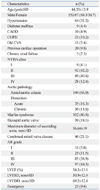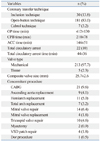1. Bentall H, De Bono A. A technique for complete replacement of the ascending aorta. Thorax. 1968. 23:338–339.

2. Kouchoukos NT, Wareing TH, Murphy SF, Perrillo JB. Sixteen-year experience with aortic root replacement. Results of 172 operations. Ann Surg. 1991. 214:308–318.
3. Svensson LG, Crawford ES, Hess KR, Coselli JS, Safi HJ. Composite valve graft replacement of the proximal aorta: comparison of techniques in 348 patients. Ann Thorac Surg. 1992. 54:427–437.

4. Pacini D, Ranocchi F, Angeli E, Settepani F, Pagliaro M, Martin-Suarez S, et al. Aortic root replacement with composite valve graft. Ann Thorac Surg. 2003. 76:90–98.

5. Hagl C, Strauch JT, Spielvogel D, Galla JD, Lansman SL, Squitieri R, et al. Is the Bentall procedure for ascending aorta or aortic valve replacement the best approach for long-term event-free survival? Ann Thorac Surg. 2003. 76:698–703.

6. Sarsam MA, Yacoub M. Remodeling of the aortic valve anulus. J Thorac Cardiovasc Surg. 1993. 105:435–438.

7. David TE, Feindel CM, Bos J. Repair of the aortic valve in patients with aortic insufficiency and aortic root aneurysm. J Thorac Cardiovasc Surg. 1995. 109:345–351.

8. David TE, Armstrong S, Ivanov J, Feindel CM, Omran A, Webb G. Results of aortic valve-sparing operations. J Thorac Cardiovasc Surg. 2001. 122:39–46.

9. Kazui T, Tsuboi J, Izumoto H, Nakajima T, Ishihara K, Kawazoe K. Aortic root remodeling with aortic annuloplasty: mid-term results. Circ J. 2007. 71:207–210.

10. Kouchoukos NT, Marshall WG Jr, Wedige-Stecher TA. Eleven-year experience with composite graft replacement of the ascending aorta and aortic valve. J Thorac Cardiovasc Surg. 1986. 92:691–705.

11. Milano AD, Pratali S, Mecozzi G, Boraschi P, Braccini G, Magagnini E, et al. Fate of coronary ostial anastomoses after the modified Bentall procedure. Ann Thorac Surg. 2003. 75:1797–1801.

12. Mautner SL, Mautner GC, Curry CL, Roberts WC. Massive perigraft aortic aneurysm late after composite graft replacement of the ascending aorta and aortic valve in the Marfan syndrome. Am J Cardiol. 1993. 71:624–627.

13. Kazui T, Yamashita K, Terada H, Washiyama N, Suzuki T, Ohkura K, et al. Late reoperation for proximal aortic and arch complications after previous composite graft replacement in Marfan patients. Ann Thorac Surg. 2003. 76:1203–1207.

14. Shiono M, Hata M, Sezai A, Iida M, Negishi N, Sezai Y. Reoperation for ascending aortic aneurysm, coronary ostial aneurysm and patent Cabrol trick after bentall operation for aortitis syndrome. Circ J. 2005. 69:861–864.

15. Donaldson RM, Ross DN. Composite graft replacement for the treatment of aneurysms of the ascending aorta associated with aortic valvular disease. Circulation. 1982. 66(2 Pt 2):I116–I121.
16. Mayer JE Jr, Lindsay WG, Wang Y, Jorgensen CR, Nicoloff DM. Composite replacement of the aortic valve and ascending aorta. J Thorac Cardiovasc Surg. 1978. 76:816–823.

17. McCready RA, Pluth JR. Surgical treatment of ascending aortic aneurysms associated with aortic valve insufficiency. Ann Thorac Surg. 1979. 28:307–316.

18. Sioris T, David TE, Ivanov J, Armstrong S, Feindel CM. Clinical outcomes after separate and composite replacement of the aortic valve and ascending aorta. J Thorac Cardiovasc Surg. 2004. 128:260–265.

19. Prifti E, Bonacchi M, Frati G, Proietti P, Giunti G, Babatasi G, et al. Early and long-term outcome in patients undergoing aortic root replacement with composite graft according to the Bentall's technique. Eur J Cardiothorac Surg. 2002. 21:15–21.

20. Sheick-Yousif B, Sheinfield A, Tager S, Ghosh P, Priesman S, Smolinsky AK, et al. Aortic root surgery in Marfan syndrome. Isr Med Assoc J. 2008. 10:189–193.
21. Crawford ES. Marfan's syndrome. Broad spectral surgical treatment cardiovascular manifestations. Ann Surg. 1983. 198:487–505.
22. Kindo M, Billaud P, Gerelli S, Levy F, Mazzucotelli JP, Eisenmann B. Twenty-seven-year experience with composite valve graft replacement of the aortic root. J Heart Valve Dis. 2007. 16:370–377.
23. Bachet J, Termignon JL, Goudot B, Dreyfus G, Piquois A, Brodaty D, et al. Aortic root replacement with a composite graft. Factors influencing immediate and long-term results. Eur J Cardiothorac Surg. 1996. 10:207–213.












 PDF
PDF ePub
ePub Citation
Citation Print
Print






 XML Download
XML Download